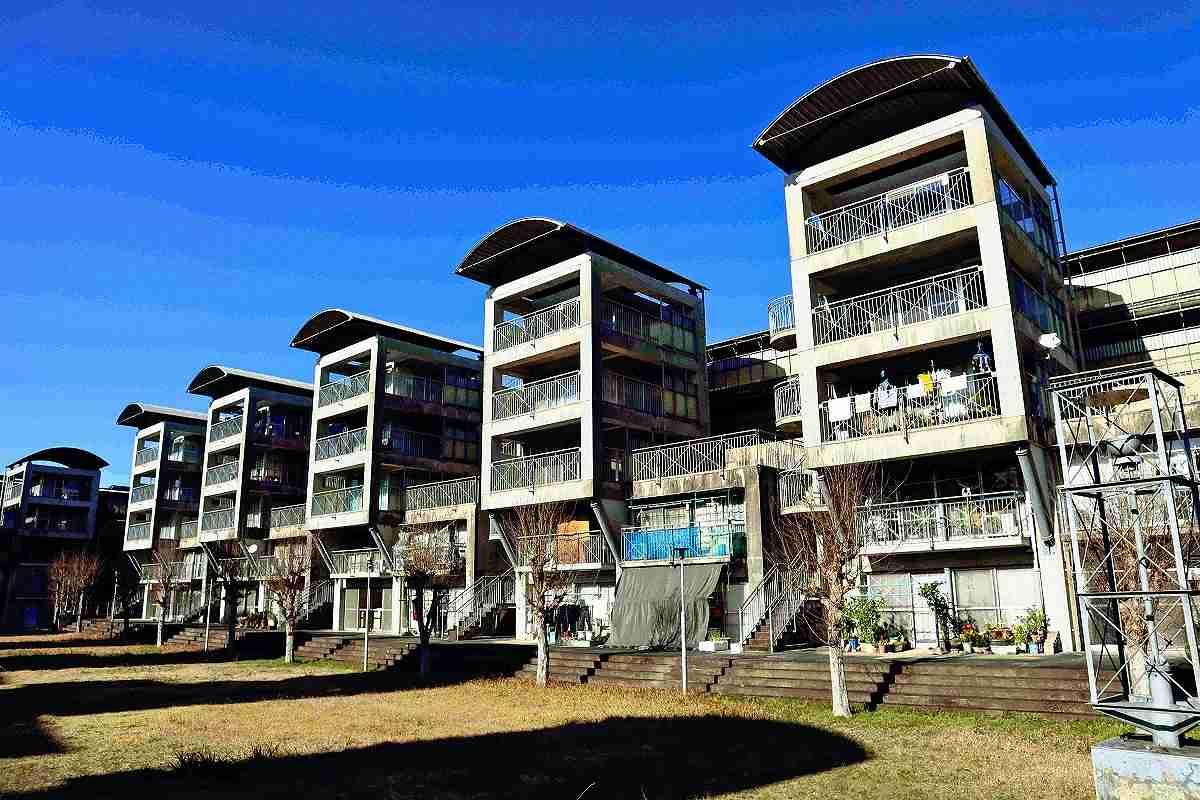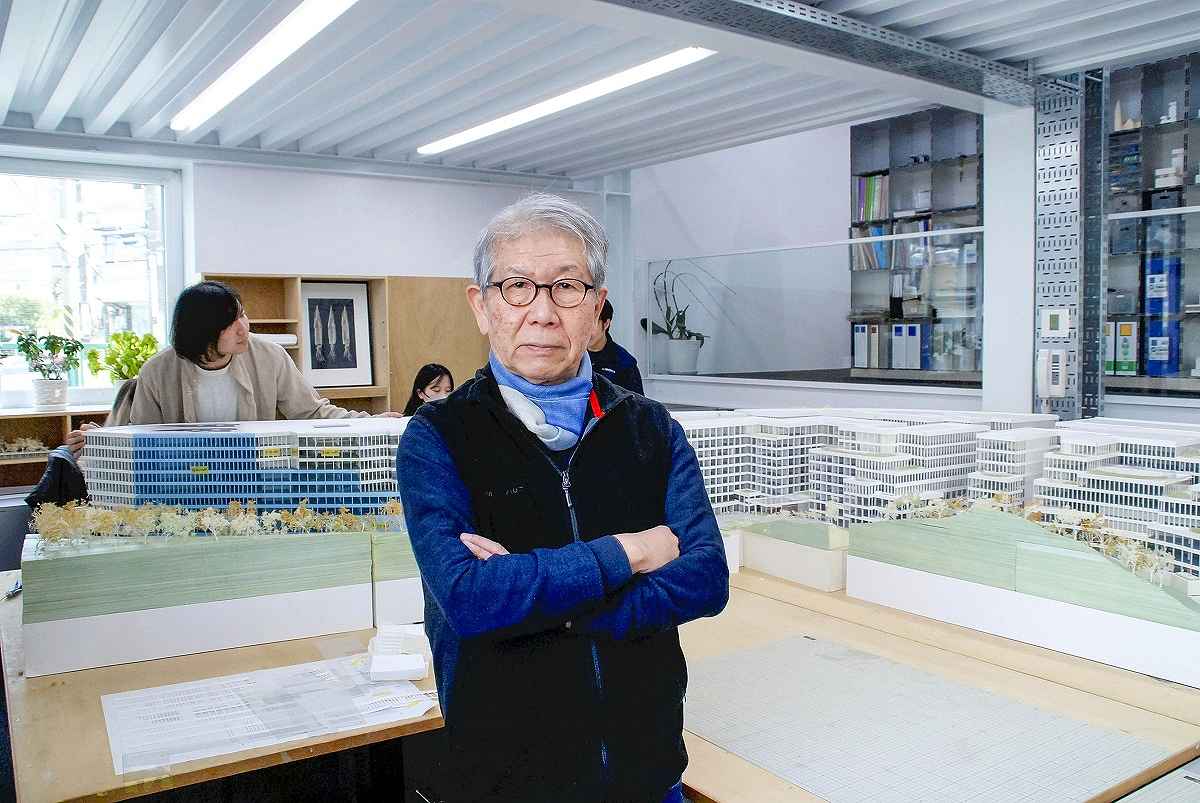Pritzker Prize Laureate Shows Thoughts on Families and Communities Through Housing Architecture

The east wing of Hotakubo Housing in Kumamoto with communal terraces on the third floor
15:02 JST, April 30, 2024
KUMAMOTO — Hotakubo Housing, a housing complex in Kumamoto City, is the first work of Japanese architect Riken Yamamoto. The housing units offer a glimpse into how this year’s U.S. Pritzker Architecture Prize laureate views the social nature of architecture.
In March, Yamamoto, 79, a visiting professor at Tokyo University of the Arts, was named as the world’s most outstanding architect in recognition of the social nature of his architecture that focuses not only on the design of buildings but also on the creation of local communities.
Three futuristic five-story buildings with exposed concrete exteriors, arched roofs and silver railings and stairs surround a courtyard in a U-shape from the east, west and north. The courtyard, faced by terraces belonging to all units, is a private space for the residents which is accessible only from the south side of the assembly hall building or by passing through each unit.
Hotakubo Housing was completed in 1991, the first housing complex built under Kumamoto Prefecture’s Kumamoto Artpolis project. There are a total of 110 units, of which 89 are currently occupied.
A neighborhood association chairman showed me around the housing. The 67-year-old company employee said he has lived here with his wife since its completion.
The housing has several floor plan types. The distinctive feature of them is that the rooms on the unit’s entrance side are separated by an exterior corridor called a “bridge” that links the dining and kitchen areas. The dining room and kitchen have glass walls on two sides.
The unit comes with spaces that respect privacy, such as a bedroom, as well as a place open to the housing’s common space. In addition, the housing has a communal terrace connected to each unit which can be accessed by stairs from the courtyard.
The unique structure initially sparked criticism. “Some residents got perplexed as their rooms can be visible from units across the yard or from the common areas,” the chairman recalled. “We could often see playful children in the courtyard, though.”
Connecting public, private spaces

Riken Yamamoto
Postwar Japanese housing complexes often adopted the European style which emphasizes privacy. Yamamoto considered these exclusive housings as an inherent contradiction, as they gather people together but do not create a community. Hotakubo Housing’s distinctive form was his challenge to this contradiction through design.
After being named a Pritzker laureate, Yamamoto said: “We don’t just design buildings. We also design the way people gather. This is the responsibility of an architect. That is what I tried to do with Hotakubo Housing.”
Yamamoto has designed many housing complexes both in Japan and abroad, while repeatedly devising ways to connect private and public spaces.
His attempts originated from field surveys that he conducted on settlements in various parts of the world when he was young. Yamamoto realized that all houses exist in a community, not in isolation. This experience led him to think of the relationship of housing with the surrounding community.
Amid a low birthrate and an aging population, along with the serious problem of solitary deaths, Yamamoto is an advocate for “Local Community Areas.” These offer people a way to live together and help each other, instead of one family living in one house. They provide support for lifestyles in terms of livelihood support, energy supply and demand systems and local economy.
However, there are some barriers to the realization of this ideal. Yamamoto proposed creating a vegetable garden in common areas of pubic housing to spur interactions among residents. The idea was successful in South Korea, but in Japan was hampered by management problems.
“Based on his settlement surveys, Yamamoto has deepened his thinking about families and communities, and has encouraged people’s behavior through spatial design,” said Tohoku University Prof. Taro Igarashi, an architecture critic. “The award is also a recognition of his attitude of believing in the power of architecture to engage society.”
"Society" POPULAR ARTICLE
-

M4.9 Earthquake Hits Tokyo, Neighboring Prefectures
-

Israeli Tourists Refused Accommodation at Hotel in Japan’s Nagano Pref., Prompting Protest by Israeli Embassy and Probe by Prefecture
-

M7.5 Earthquake Hits Northern Japan; Tsunami Waves Observed in Hokkaido, Aomori and Iwate Prefectures
-

Tsukiji Market Urges Tourists to Avoid Visiting in Year-End
-

High School in Kyoto Says Students Shoplifted during Recent School Trip to Bali, Indonesia
JN ACCESS RANKING
-

Tokyo Economic Security Forum to Hold Inaugural Meeting Amid Tense Global Environment
-

Keidanren Chairman Yoshinobu Tsutsui Visits Kashiwazaki-Kariwa Nuclear Power Plant; Inspects New Emergency Safety System
-

Imports of Rare Earths from China Facing Delays, May Be Caused by Deterioration of Japan-China Relations
-

University of Tokyo Professor Discusses Japanese Economic Security in Interview Ahead of Forum
-

Japan Pulls out of Vietnam Nuclear Project, Complicating Hanoi’s Power Plans























